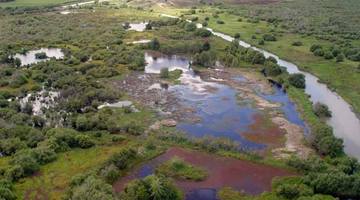Researcher and project manager Cheri van Schravendijk-Goodman describes some of the projects taking place in Whangamarino Wetland. Scholarship students have been given the opportunity to work with scientists on projects such as investigating the effects of chemical spray on pest plants like willow, investigating the effects of fertiliser on wetland root mass and investigating predator control.
Transcript
CHERI VAN SCHRAVENDIJK-GOODMAN
Our scholarship students that are working in this programme with Wintec had the opportunity to work directly with Landcare Research scientists and NIWA scientists, working in Whangamarino Wetland, which is one of the big wetlands we have in the lower Waikato. And they got to do really interesting work looking at the effects of chemical spray for willow control in Whangamarino and looking at what the revegetation was like underneath that. Are our natives coming back or are the willows just going crazy again after those treatments? They also were involved in a project that involved some international scientists as well, looking at the effects of fertiliser on wetland root mass.
We have three types of wetlands in New Zealand, and they’re all found here. We have peat bogs, our fens and our swamps. So swamps are the really, really wet ones, you know, they’re the ones you get where you fall in holes and you’re covered in water up to here. The peat bogs sort of have a water table underneath that causes this thing to sort of rise and fall with the water table underneath it.
And so they were looking at the effects of things like nitrogen and phosphorous on the root mass that’s produced by the plants, and that root mass is really important because it could be a source of locking up carbon, there could be heaps of carbon being locked up in there. Is it affecting the formation of peat and stuff?
We’re now looking at what are the effects of biosecurity issues. Now, biosecurity is when a biological organism becomes a problem, and it could be it has a problem on an economic development like agriculture. It has an environmental effect or it could have a health issue. We’ve asked the Department of Conservation to take on our student, and she is out there learning about predator control around Whangamarino.
Some of the worst vertebrate pests that we have in Whangamarino are stoats and feral cats. People don’t appreciate how much of an impact they have, but they go after our native birds that live in these wetlands. We’ve got to remember that our native birds evolved in New Zealand without any kind of mammalian predator. The predators they had were these great big eagles or carrion birds like the morepork, the ruru and the kāhu.
So she’s going out there and doing quite a bit of work with them on that and looking at how these animals move around the wetlands and do they prefer certain vegetation over other vegetation and how do you control them based on that information.
Acknowledgements:
Cheri van Schravendijk-Goodman
Karyn Okeroa-McCrae
Timi Manukau
Dr Beverley Clarkson, Landcare Research
Josh Ormsby; Jonathan Brown; Scott Bartlam; Kerry Bodmin
Keven Law, http://creativecommons.org/licenses/by-sa/2.0/deed.en
Julie Burgher
John Megahan, http://creativecommons.org/licenses/by/2.5/
Digitaltrails, http://creativecommons.org/licenses/by-nc-sa/2.0/
Certain photos in this video are the copyrighted property of 123RF Limited, their contributors or licensed partners and are being used with permission under licence. These images and/or photos may not be copied or downloaded without permission from 123RF Limited.
The Waikato Tainui College for Research and Development acknowledges the financial support given by the Waikato River Cleanup Trust Fund which is administered by the Waikato River Authority.
The Waikato River Cleanup Trust does not necessarily endorse or support the content of the publication in any way.


